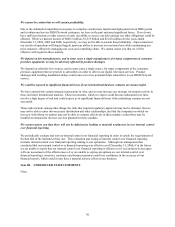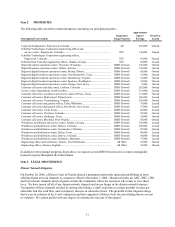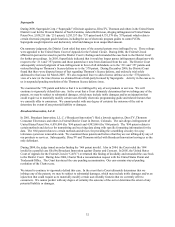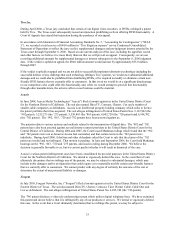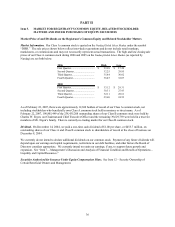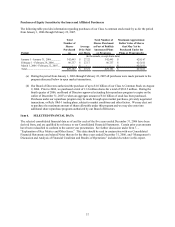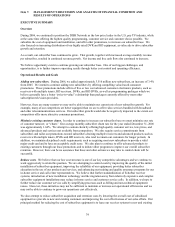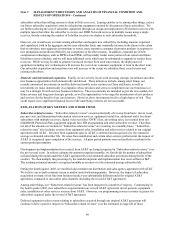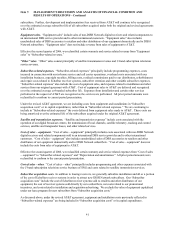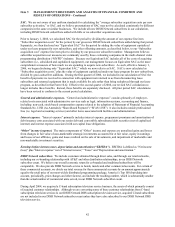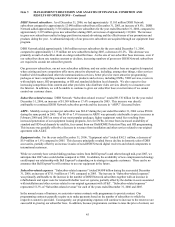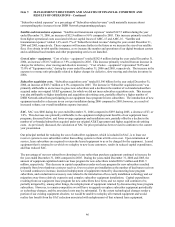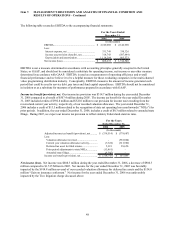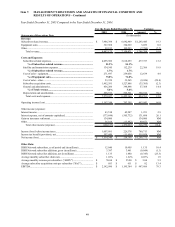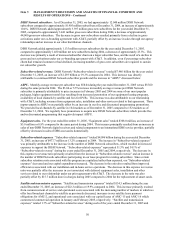Dish Network 2005 Annual Report Download - page 50
Download and view the complete annual report
Please find page 50 of the 2005 Dish Network annual report below. You can navigate through the pages in the report by either clicking on the pages listed below, or by using the keyword search tool below to find specific information within the annual report.Item 7. MANAGEMENT’S DISCUSSION AND ANALYSIS OF FINANCIAL CONDITION AND
RESULTS OF OPERATIONS – Continued
40
subscribers rather than selling systems to them at little or no cost. Leasing enables us to, among other things, reduce
our future subscriber acquisition costs by redeploying equipment returned by disconnected lease subscribers. We
are further reducing the cost of subscriber equipment through our design and deployment of EchoStar receivers with
multiple tuners that allow the subscriber to receive our DISH Network services in multiple rooms using a single
receiver, thereby reducing the number of EchoStar receivers we deploy to each subscriber household.
However, our overall costs to retain existing subscribers and acquire new subscribers, including amounts expensed
and capitalized, both in the aggregate and on a per subscriber basis, may materially increase in the future to the extent
that we introduce more aggressive promotions or newer, more expensive consumer electronics products in response to
new promotions and products offered by our competitors or for other reasons. In addition, expanded use of new
compression technologies, such as MPEG-4 and 8PSK, will inevitably render some portion of our current and future
EchoStar receivers obsolete, and we will incur additional costs, which may be substantial, to upgrade or replace these
receivers. While we may be able to generate increased revenue from such conversions, the deployment of
equipment including new technologies will increase the cost of our consumer equipment, at least in the short term.
Our subscriber acquisition and retention costs will increase to the extent we subsidize those costs for new and
existing subscribers.
Domestic and international expansion. Finally, we are actively involved in pursuing strategic investment and other
new business opportunities both domestically and abroad. These initiatives include, among other things, our
recently announced investments in satellite-delivered mobile video ventures in China and Korea, as well as
investments we make domestically in companies whose products and services complement our core businesses or
may be a strategic fit with our new business initiatives. These investments are intended to provide new markets for
future revenue and long term strategic growth, as well as opportunities to leverage the introduction of new products
and services for the benefit of our core business. However, these investments involve a high degree of risk. They
could expose us to significant financial losses if the underlying ventures are not successful.
EXPLANATION OF KEY METRICS AND OTHER ITEMS
Subscriber-related revenue. “Subscriber-related revenue” consists principally of revenue from basic, movie, local,
pay-per-view, and international subscription television services, equipment rental fees, additional outlet fees from
subscribers with multiple receivers, digital video recorder (“DVR”) fees, advertising sales, fees earned from our
DishHOME Protection Plan, equipment upgrade fees, HD programming and other subscriber revenue. Therefore,
not all of the amounts we include in “Subscriber-related revenue” are recurring on a monthly basis. “Subscriber-
related revenue” also includes revenue from equipment sales, installation and other services related to our original
agreement with AT&T. Revenue from equipment sales to AT&T is deferred and recognized over the estimated
average co-branded subscriber life. Revenue from installation and certain other services performed at the request of
AT&T is recognized upon completion of the services. All prior period amounts were reclassified to conform to the
current period presentation.
Development and implementation fees received from AT&T are being recognized in “Subscriber-related revenue” over
the next several years. In order to estimate the amount recognized monthly, we first divide the number of subscribers
activated during the month under the AT&T agreement by total estimated subscriber activations during the life of the
contract. We then multiply this percentage by the total development and implementation fees received from AT&T.
The resulting estimated amount is recognized monthly as revenue over the estimated average subscriber life.
During the fourth quarter 2005, we modified and extended our distribution and sales agency agreement with AT&T.
We believe our overall economic return is similar under both arrangements. However, the impact of subscriber
acquisition on many of our line item business metrics was substantially different under the original AT&T
agreement, compared to most other sales channels (including the revised AT&T agreement).
Among other things, our “Subscriber-related revenue” has been impacted in a number of respects. Commencing in
the fourth quarter 2005, new subscribers acquired under our revised AT&T agreement do not generate equipment
sales, installation or other services revenue from AT&T. However, our programming services revenue is greater for
subscribers acquired under the revised AT&T agreement.
Deferred equipment sales revenue relating to subscribers acquired through our original AT&T agreement will
continue to have a positive impact on “Subscriber-related revenue” over the estimated average life of those


